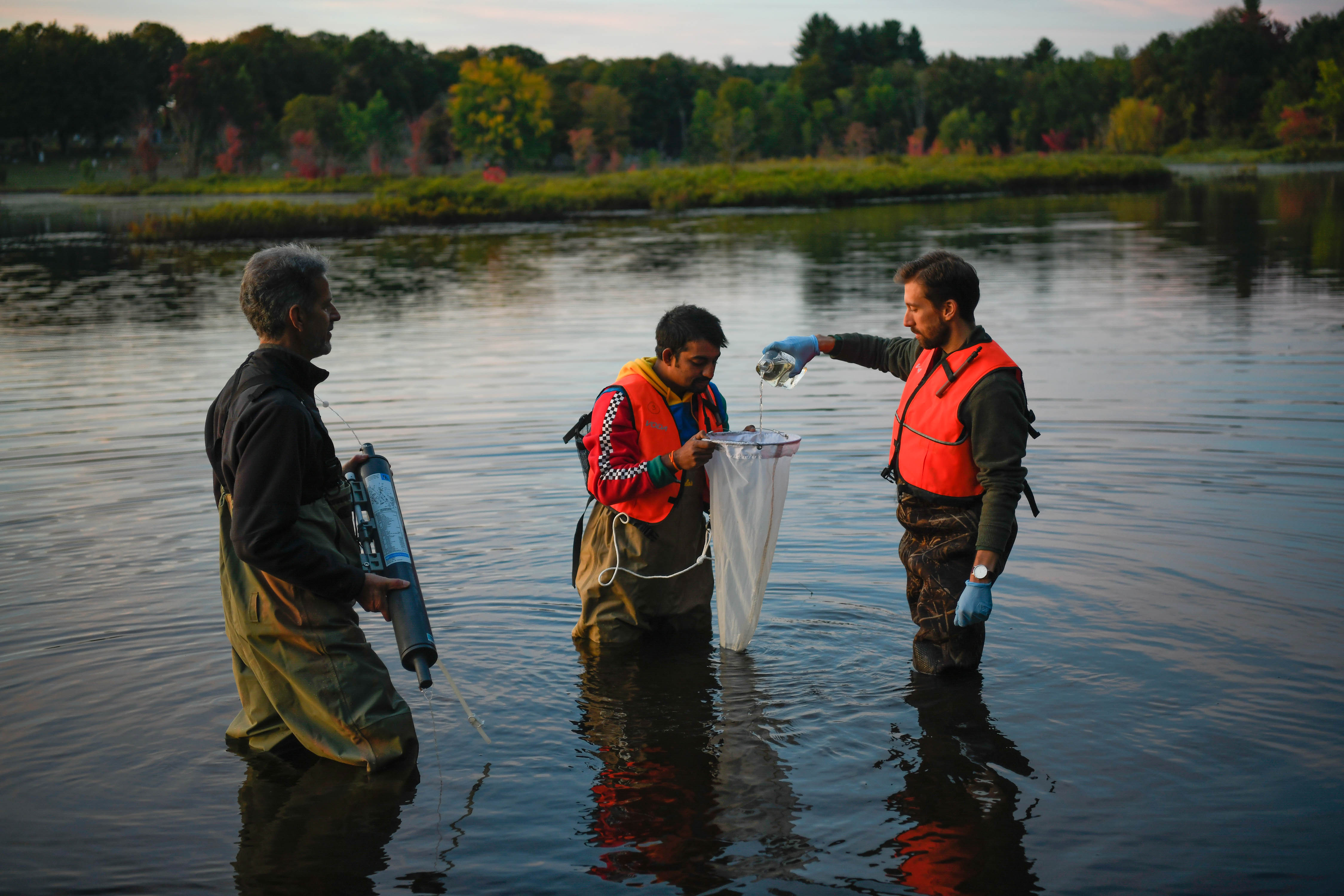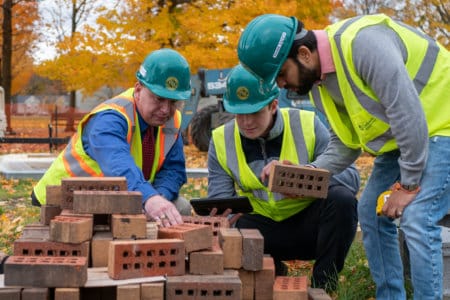Situated in the scenic landscape of New York’s North Country, Clarkson University stands out for its academic excellence and its steadfast commitment to sustainability. It is making significant strides in aligning the campus with the United Nations’ Sustainable Development Goals (SDGs), both inside and outside the classroom. This approach embeds the SDGs into the University’s curriculum, campus operations, research and community outreach, fostering a culture of environmental stewardship and social responsibility.
Susan E. Powers, professor and director of Clarkson’s Institute for a Sustainable Environment, notes that Clarkson was recently awarded a gold rating for the third time in the Sustainability Tracking, Assessment & Rating System (STARS) of the Association for the Advancement of Sustainability in Higher Education. This looks at the efforts of institutions to implement comprehensive approaches to sustainability.

Dr. Susan Powers, director of Clarkson University’s Institute for a Sustainable Environment. Source: Clarkson University
“Clarkson’s strengths and leadership are reflected in our broad inclusion of sustainability in classes and research across almost all of our degree programmes; provision of nearly 100% of our electricity on the Potsdam campus from zero-emission renewable sources; and our coordination and planning activities related to sustainability,” she notes.
“We take our goals seriously, using the SDGs as a guide. But students are at the heart of all we do,” notes Powers. “They help us prioritise and carry out Clarkson’s efforts.” A prime example is the University’s comprehensive recycling and composting programme, which significantly reduces waste sent to landfills. Additionally, Clarkson’s dining services prioritise sourcing locally produced, sustainable food, thereby minimising the environmental impact of food consumption.
Among the 17 UN SDGs, here are six where Clarkson’s efforts are particularly distinctive.
Goal 4: Quality Education
Clarkson University excels in providing inclusive and equitable programmes that align with SDG Goal 4. They are focused on sustainability, including environmental science, renewable energy engineering, and sustainable business practices. This allows students to identify connections between research, practice, and decision-making that enhance critical thinking with a focus on the future they will forge after graduation. The Institute for Sustainable Environment (ISE) at Clarkson provides a hub for the University’s efforts.
Goal 7: Affordable and Clean Energy
Clarkson University’s commitment to Goal 7 — ensuring access to affordable, reliable, sustainable and modern energy for all — is evident through its pioneering research and campus initiatives. Its Centre for Sustainable Energy Systems (CSES) conducts advanced research in renewable energy technologies, including solar, wind and bioenergy.
One notable project is the University’s collaboration with the New York State Energy Research and Development Authority (NYSERDA) to develop innovative energy storage solutions. These projects aim to make renewable energy sources more viable and accessible for both the University community and society at large.
Goal 11: Sustainable Cities and Communities
Earlier this year, Clarkson announced the appointment of Erik Backus, professor of practice and director of the Construction Engineering Management programme, to the International Sustainable Communities Committee (ISCC). More than a well-deserved personal accolade for Backus, this appointment is a testament to Clarkson’s leadership in sustainable practices and community development.
Backus’ role involves collaborating with international experts to develop and implement strategies for sustainable living. By working towards the creation of inclusive, safe, resilient and sustainable urban environments, Clarkson is contributing to a broader global effort to improve living conditions and reduce environmental impact.
Beyond environmental and ecological concerns, the ISCC focuses on aspects of sustainable community development, including affordable housing, sustainable transport systems and improving urban planning.
Goal 13: Climate Action
In line with Goal 13, Clarkson University is a champion of climate action. The University has committed to carbon neutrality by 2025, a goal pursued through a combination of energy efficiency measures, renewable energy projects and carbon offset initiatives.
The University’s Climate Action Plan outlines a strategic approach to reducing greenhouse gas emissions, enhancing energy efficiency, and fostering a culture of sustainability. Its participation in the American College & University Presidents’ Climate Commitment (ACUPCC) further underscores its dedication to combating climate change.
Goals 14 and 15: Life Below Water and Life on Land
In another groundbreaking initiative, Clarkson University is leading research on aquatic invasive species in Upstate New York — a project that has far-reaching implications for environmental sustainability and biodiversity. This aligns with SDG 14: Life Below Water, which aims to conserve and sustainably use the oceans, seas and marine resources. The primary invasive plant species being studied grow very fast, outcompeting native plants to form a monoculture that has various negative ecological impacts.
Clarkson’s research focuses on understanding the impact of invasive species on local ecosystems and developing strategies to mitigate their effects. Students involved in the project gain field experience collecting data on the species — and data analysis experience — using their data to build mathematical models to predict the spread of the invasive species in St. Lawrence River waterways.

Clarkson’s on-campus garden and greenhouse. Source: Clarkson University
This project also touches upon SDG 15: Life on Land, as the health of aquatic systems is intrinsically linked to terrestrial ecosystems. Invasive species can disrupt local habitats, leading to broader ecological consequences.
The goal of Clarkson’s team is to determine the plant’s growth and spreading rates, which will be used to calibrate a predictive mathematical model of future growth and spread. The model will be used to simulate various control strategies. “Our project is truly collaborative, incorporating fieldwork during the summer and math modelling during the colder months,” states lead investigator, mathematics Professor Diana White. “Undergraduate students will have the unique opportunity to work on both biological and mathematical aspects of the project, allowing students to get hands-on experience with quantitative methods, which will allow them to make quantitative decisions as to the best way to control the invasive plant.”
A Model for Sustainable Development
Clarkson exemplifies how higher education institutions can play a pivotal role in advancing the UN’s Sustainable Development Goals. “Clarkson’s regional partnerships and work on statewide climate programmes allow students to be involved in local and statewide climate solutions that can have global impacts,” says graduate student Caroline Dodd. “New York State is widely considered a policy leader on climate change in the United States, and Clarkson plays a significant role in the implementation of these policies. As the state’s Climate Leadership and Community Protection Act is implemented over the coming years, Clarkson and its alumni will help the state achieve its ambitious emissions reduction goals.”
Clarkson’s efforts go beyond isolated projects, reflecting a holistic approach to sustainability that interlinks aspects of environmental, social and economic health. By engaging in international committees and leading critical environmental research, the University not only adheres to the UN SDGs but also sets a standard for other institutions to follow.
To view a playlist of video shorts highlighting the work of Clarkson’s Institute for Sustainable Environment visit: https://www.youtube.com/channel/UCUVgLx9FNAjIHCt28bxW8yQ.
Follow Clarkson University on Facebook, X, and YouTube












